Submitted:
06 October 2024
Posted:
07 October 2024
You are already at the latest version
Abstract
Keywords:
CHAPTER ONE
1.1. Background
1.2. Problem Statement
1.3. Research Questions
- 1.
- How can region-specific thunderstorm prediction model be created?
- What are the historical patterns and frequency of thunderstorms in Wa?
- What is the trend of meteorological conditions in Wa?
- What main meteorological factors influence thunderstorms formation in Wa?
- How can a thunderstorm prediction model be created based on historical meteorological data in Wa?
- To create a thunderstorm prediction model tailored to Wa.
- To evaluate historical trends in thunderstorms frequency in Wa.
- To evaluate the meteorological trends in Wa.
- To determine the meteorological parameters affecting thunderstorms formation
- To create a thunderstorm prediction model based on historical meteorological data in WA.
1.4. Significance of the Study
1.4.1. Introduction
1.4.2. Farmers’ Climate Adaptation
1.4.3. Food Security
1.4.4. Effective Resource Use
1.4.5. Climate Adaptation
1.4.6. Policy Formulation
1.4.7. Improvement of scientific understanding
1.4.8. Local and International Relevance
1.5. Scope of Study
1.6. Organization of The Study
CHAPTER TWO
2.1. Literature Review2.2. Introduction
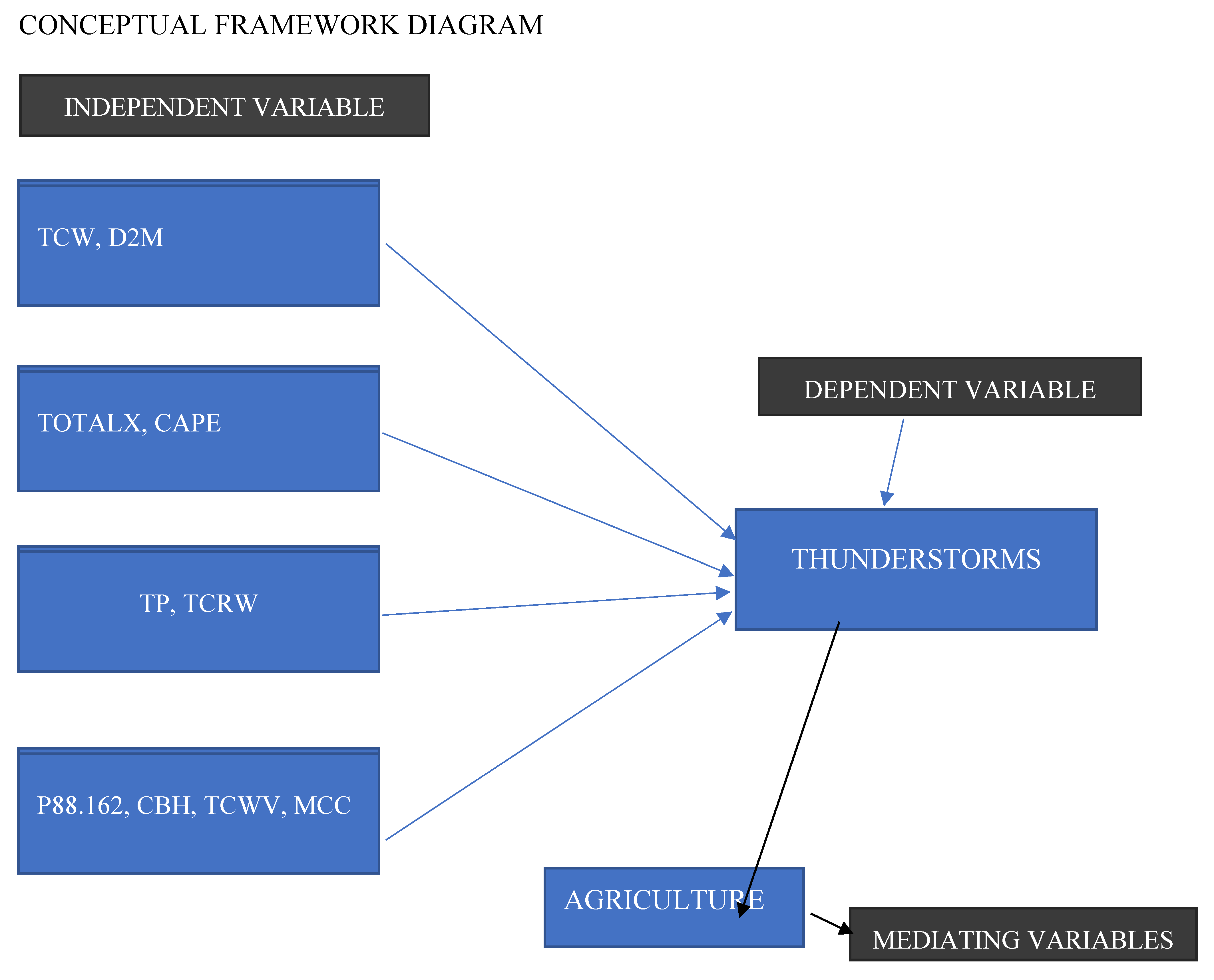
- TCW, D2M: Total Column Water and Dew Point at 2 meters. These variables represent atmospheric moisture content, which is important for thunderstorm development.
- TOTALX, CAPE: TOTALX , a stability index and Convective Available Potential Energy. These parameters show atmospheric instability, an important factor for thunderstorm formation.
- TP, TCRW: Total Precipitation and Total Column Rain Water. These variables show the presence of water in the atmosphere, both as potential rain and as existing precipitation.
- P88.162, CBH, TCWV, MCC: This group includes Vertical integral of eastward cloud liquid water flux (P88.162), Cloud Base Height (CBH), Total Column Water Vapor (TCWV), and Mesoscale Convective Complexes (MCC). These variables represent a mix of atmospheric conditions that can influence thunderstorm development or formation.
CHAPTER THREE
3.1. Study Area
3.2. Relief, Drainage and Topography
3.3. Weather
3.4. Land Use
3.5. Agriculture
3.5.1. Pito Brewing
3.6. Research Methodology
3.6.1. Research Approach
3.6.2. Sources of Data
3.6.4. Method
3.6.7. Model Development
- Machine Learning Models: Time series analysis and a machine learning method, Random Forest was employed.
- Training and testing sets: The dataset was divided into training and testing sets to enable the machine learning models to be trained. 20% was used for the testing 80% for the training.
- Model Training: Machine learning models are trained using historical thunderstorm data as the target variable and climate variables as predictors.
3.6.8. Machine Learning Algorithms to be Used
- Random Forest: Random Forest is an ensemble learning technique that mixes several different decision trees to identify deep correlations in the data. It was aid in dealing with non-linearities.
3.6.9. Model Evaluation
3.6.10. Performance Metrics
- Mean Absolute Error: Mean absolute error measures the average absolute differences between the predicted and actual crop yield
- Root Mean Squared Error: It quantifies the square root of the average differences between predicted and actual crop yield.
- MAE=
- RMSE =
3.6.11. Results Presentation
- Data Visualization: Results are presented using visualizations, including charts and graphs, to help interpret the relationship between climate variables or parameters and thunderstorm frequency.
- Interpretation of data: The findings are analyzed in the context of climate trends and their implications for crop productivity yield in Wa.
CHAPTER 4
4.1. Introduction
4.2. Model Performance Evaluation
| METRIC | VALUE |
| MAE | 2.34 |
| MSE | 9.64 |
| RMSE | 3.11 |
| R2 | 0.73 |
4.2.1. Interpretation and Discussion
| Features In Abbreviation | Full Meaning |
| TCW | Total Column Water |
| TCRW | Total Column Water Vapor |
| TCWV | Total Column Water Vapor |
| CAPE | Convective Available Potential Energy |
| MCC | Mesoscale Convective Complex |
| P88.162 | Vertical integral of eastward cloud liquid water flux |
| TP | Total Precipitation |
| TOTALX | Total Totals Index |
| CBH | Cloud Base Height |
| D2M | 2-meter Dewpoint Temperature |
4.3. Trend Analysis of Thunderstorms
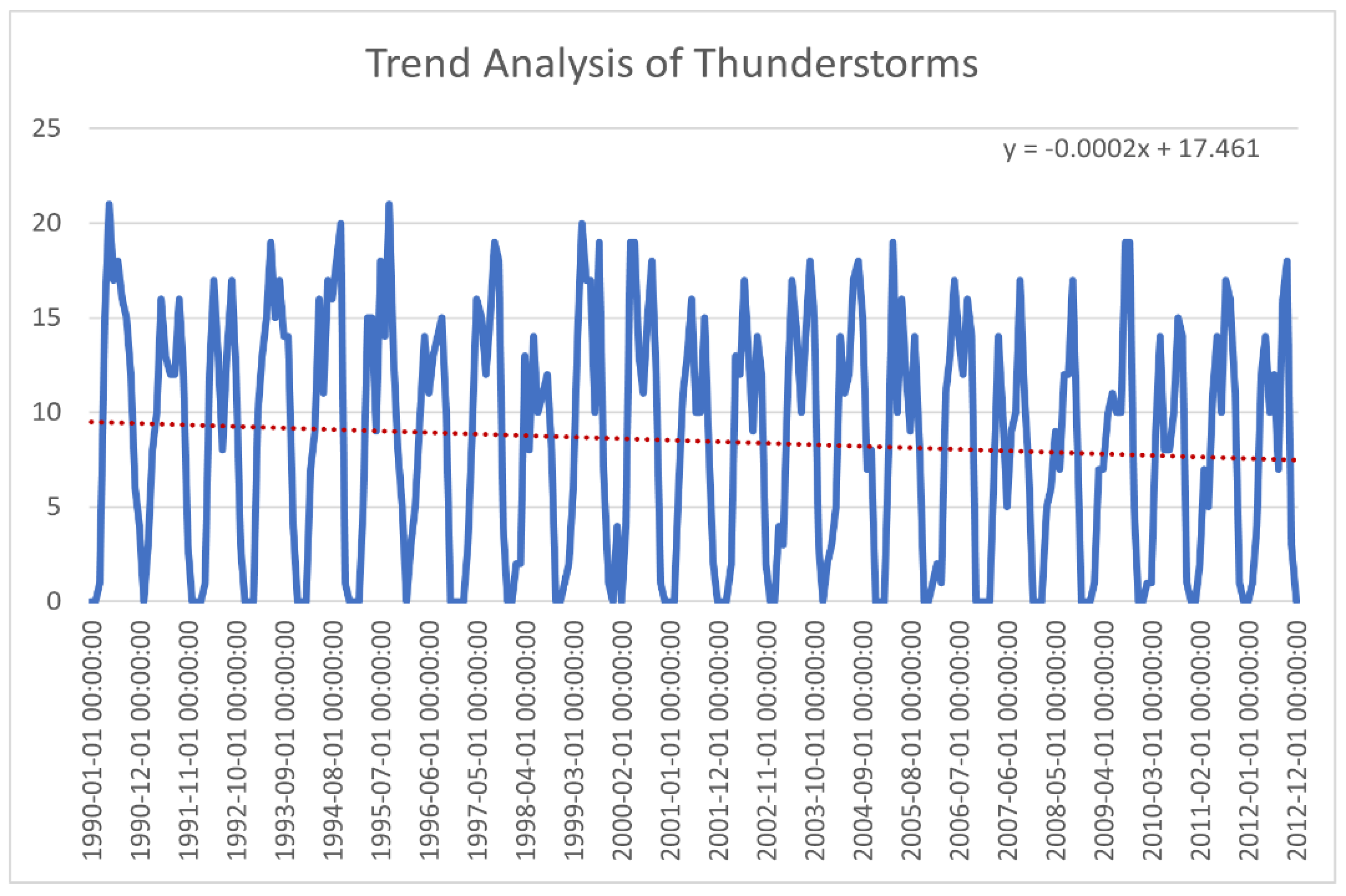
4.4. Feature Correlation with Thunderstorm Frequency
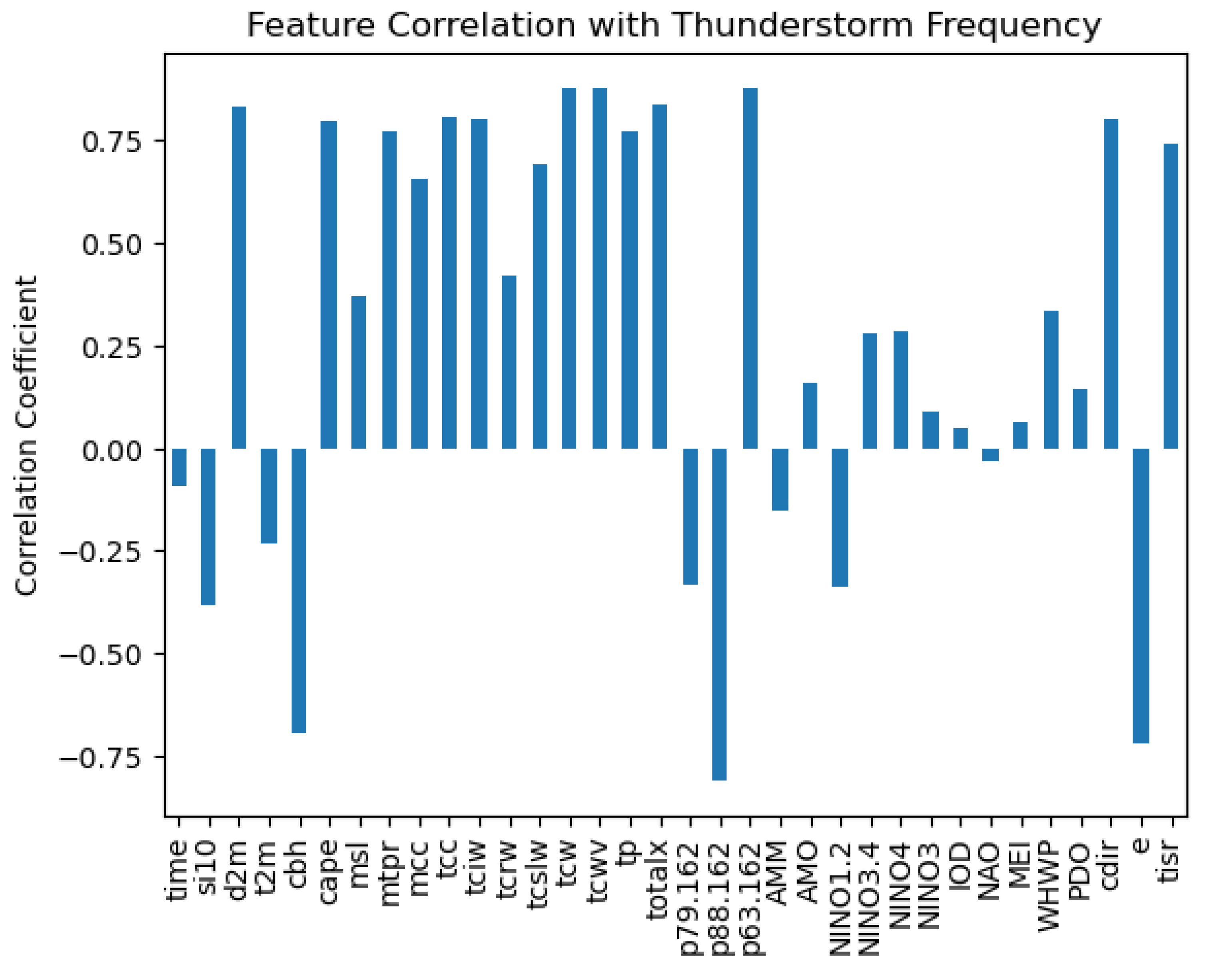
4.5. Thunderstorms Cycles
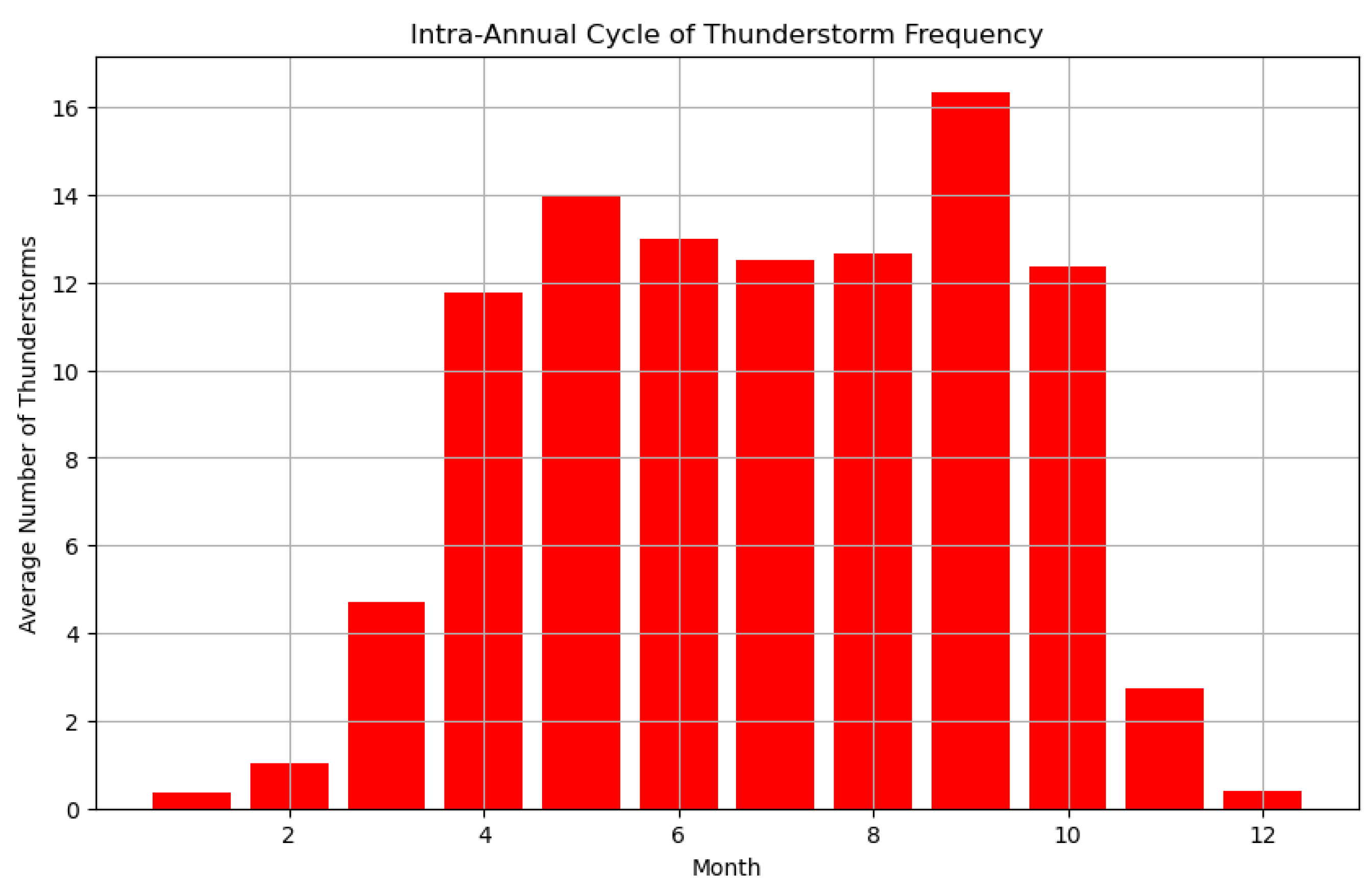
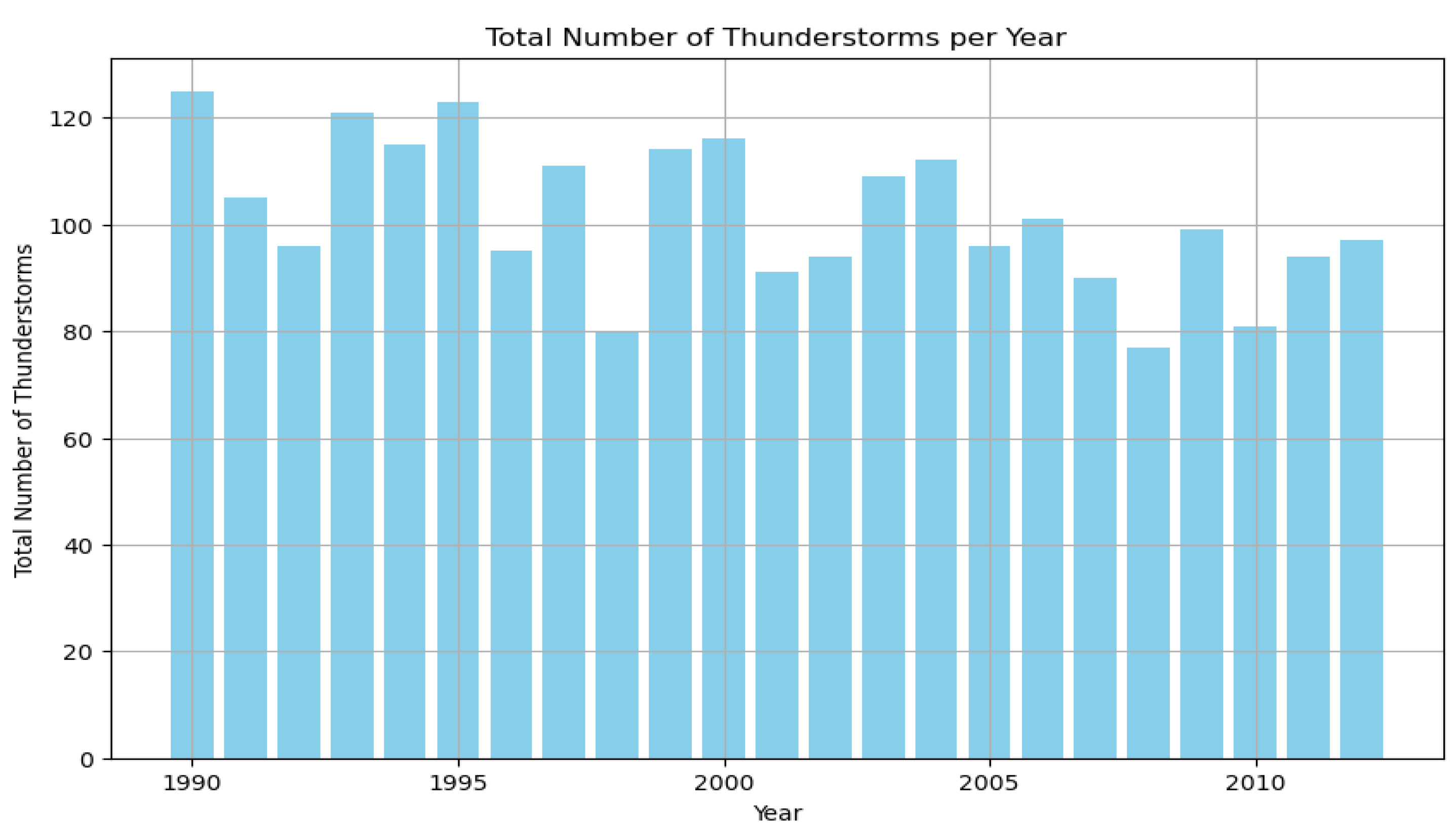
4.5. Decomposition of Thunderstorms Data
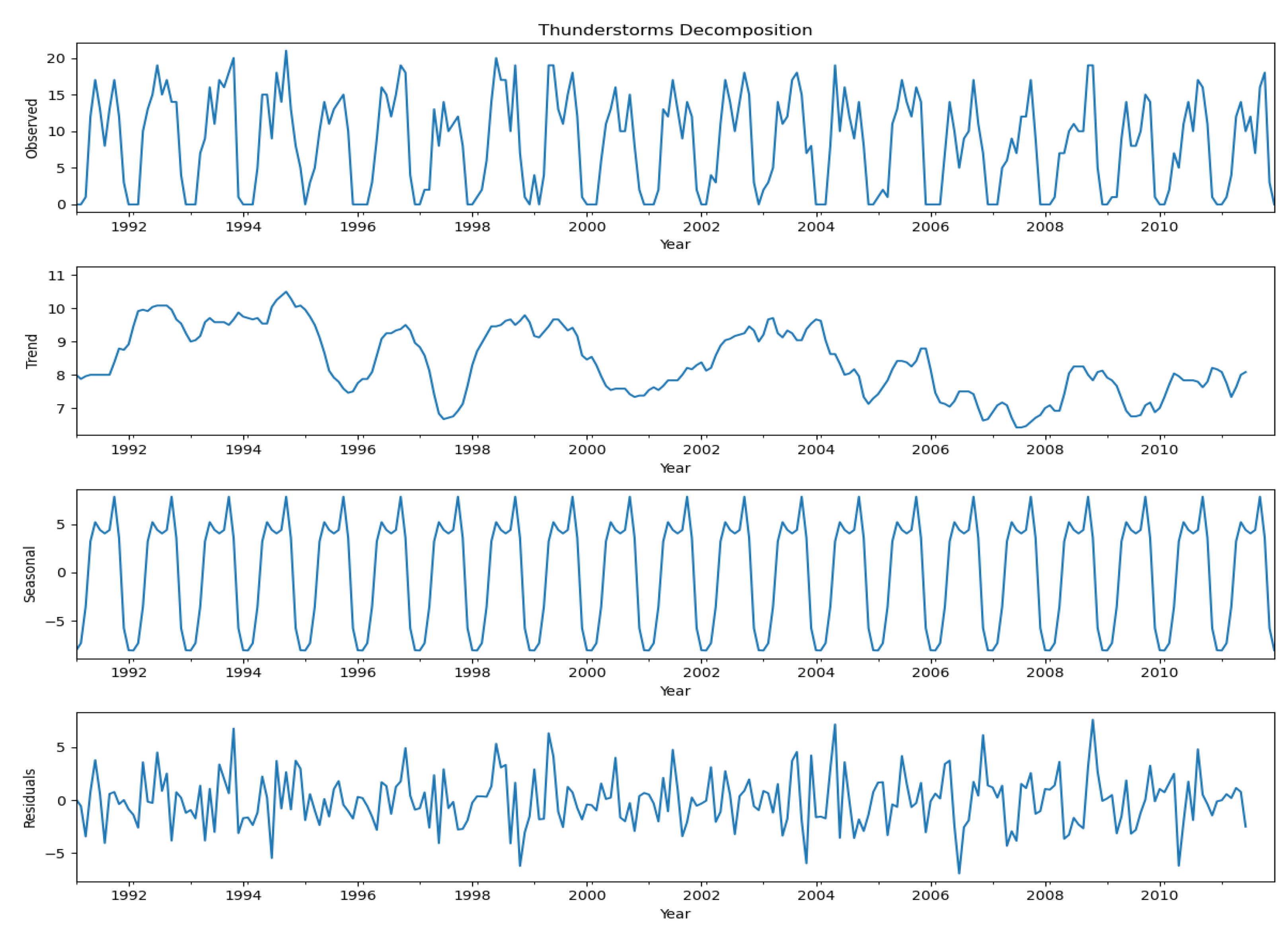
4.6. K-Means Clustering of Thunderstorm Events
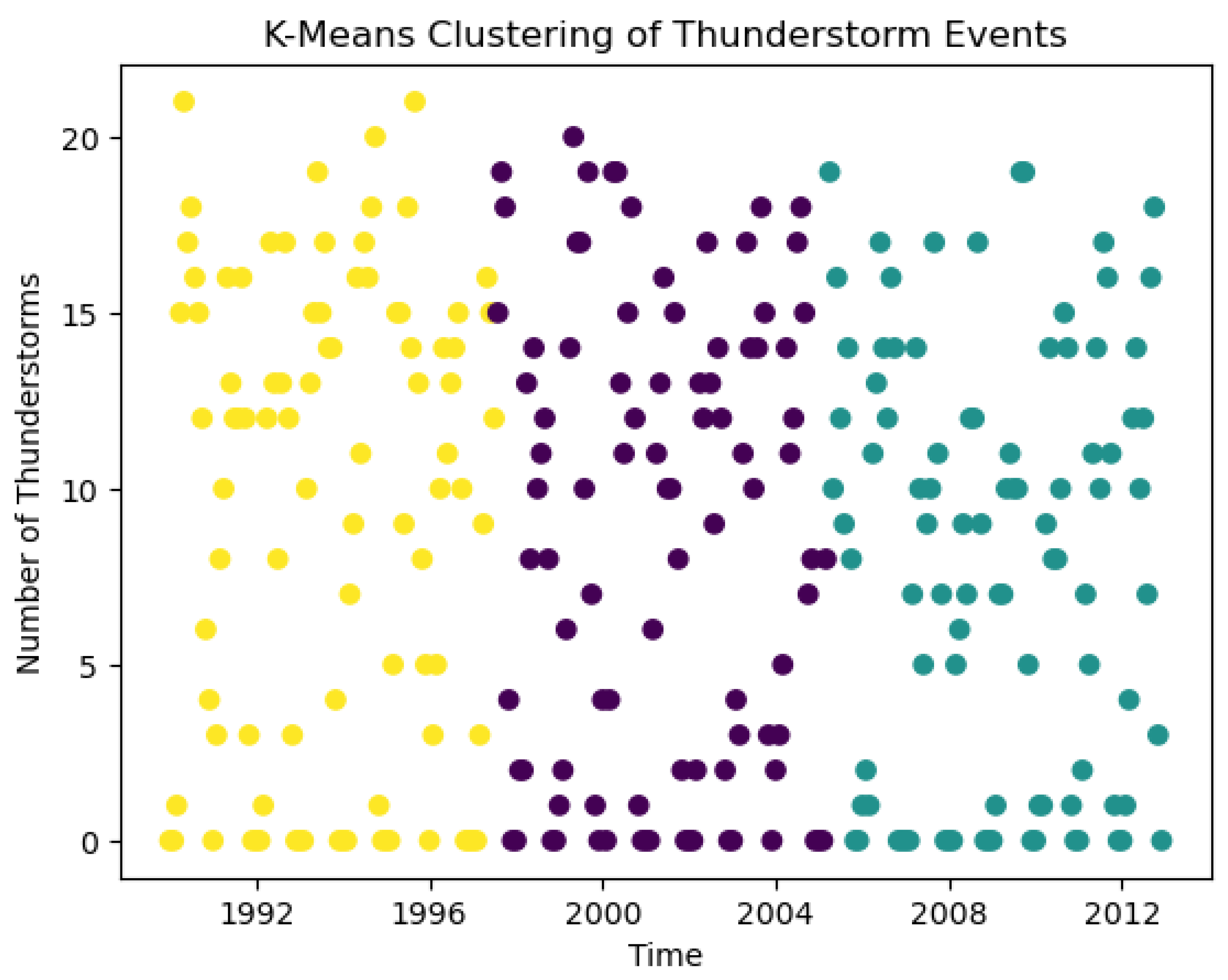
4.7. Comparisons with Observation
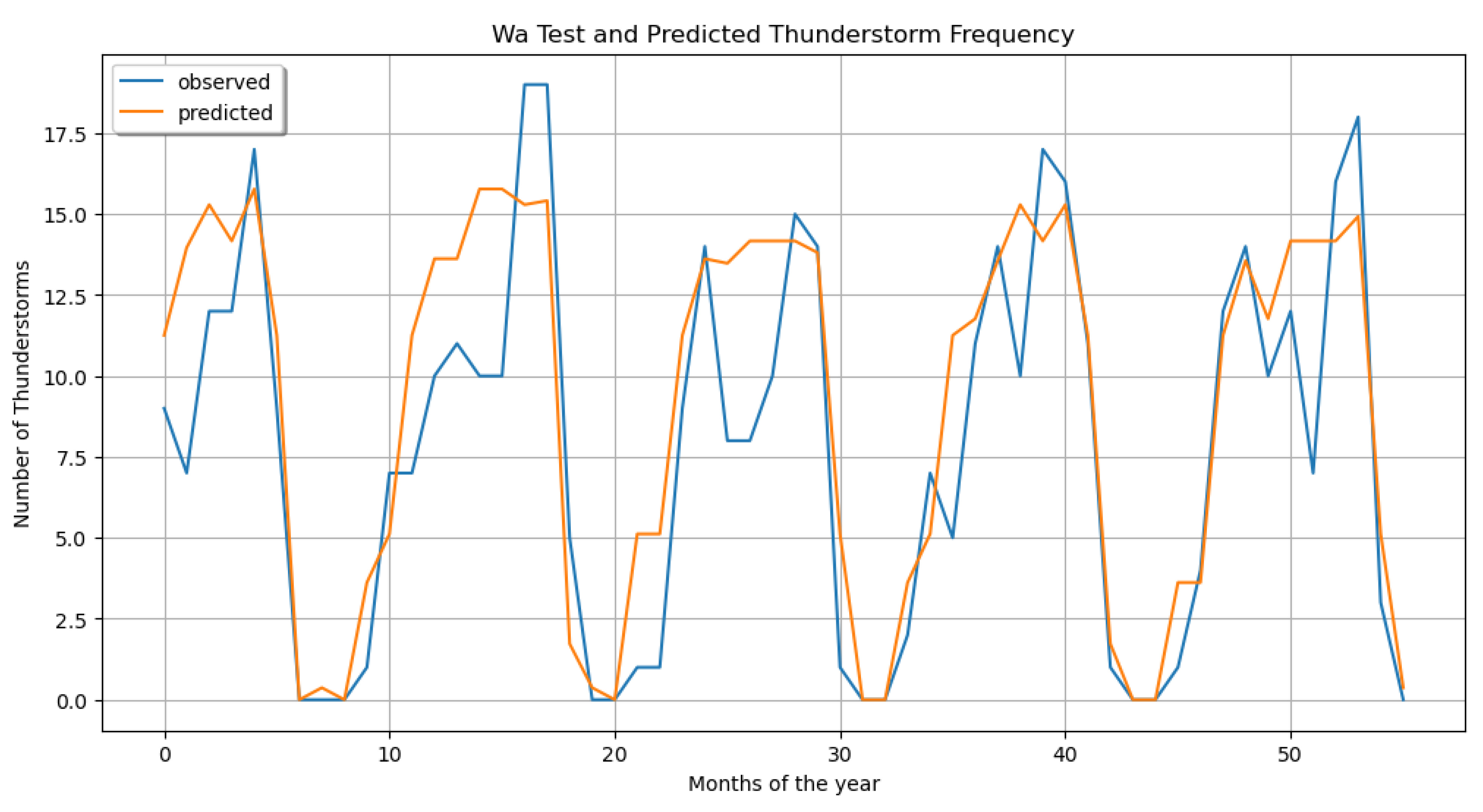
- I.
- Model Performance:
- II.
- Comparison with Observations:
- Seasonal Patterns: The model successfully captured the cyclical nature of thunderstorm occurrences, with peaks and troughs aligning well between predicted and observed values. This suggested that the model effectively learned the seasonal variations in thunderstorm frequency.
- Magnitude Alignment: In many instances, the predicted thunderstorm frequency closely matched the observed frequency, particularly during periods of low activity (near zero occurrences) and moderate activity (around 10-15 thunderstorms).
- Peak intensity: The model showed some limitations in predicting extreme peaks. For example, around March, there was a sharp observed peak of about 19 thunderstorms, which the model underestimated, predicting around 15 thunderstorms.
- Lag in the Predictions: At certain points, there appeared to be a small lag between the predicted and observed values. This was particularly noticeable around July and September, where the predicted peaks and troughs seemed to occur slightly after the observed ones.
- Overestimation during Low Activity: In some low-activity periods, such as around month 5, the model had tended to overestimate the number of thunderstorms, predicting activity when there were actually very few or no observed thunderstorms.
- Variability Capture: While the model captured the overall trend well, it sometimes smoothed out the short-term variability present in the observed data. This was evident in the more jagged appearance of the observed line compared to the smoother predicted line.
4.8. Scatter Plot Showing The Model Performance
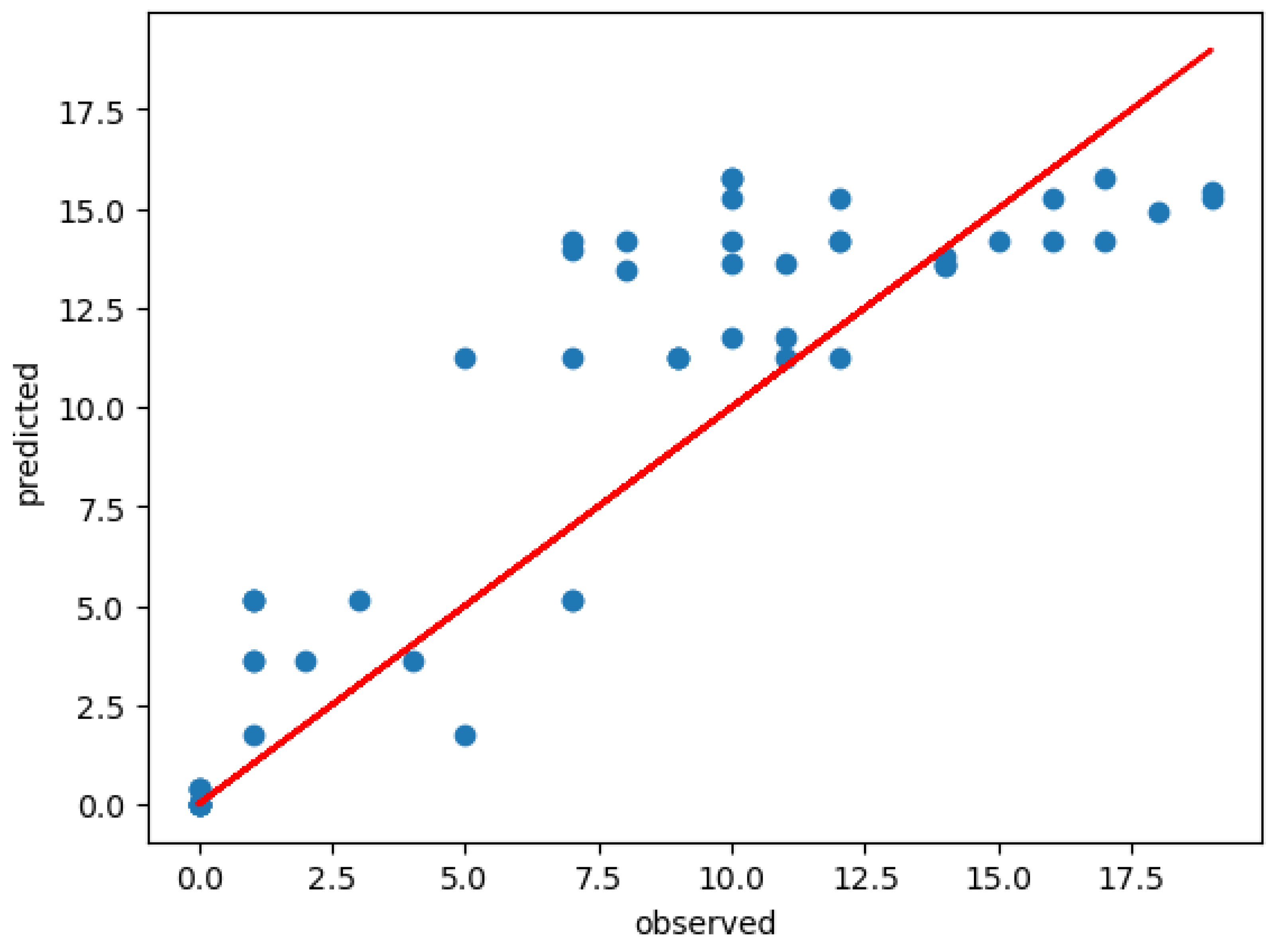
- Model Performance:
4.9. Feature Importance
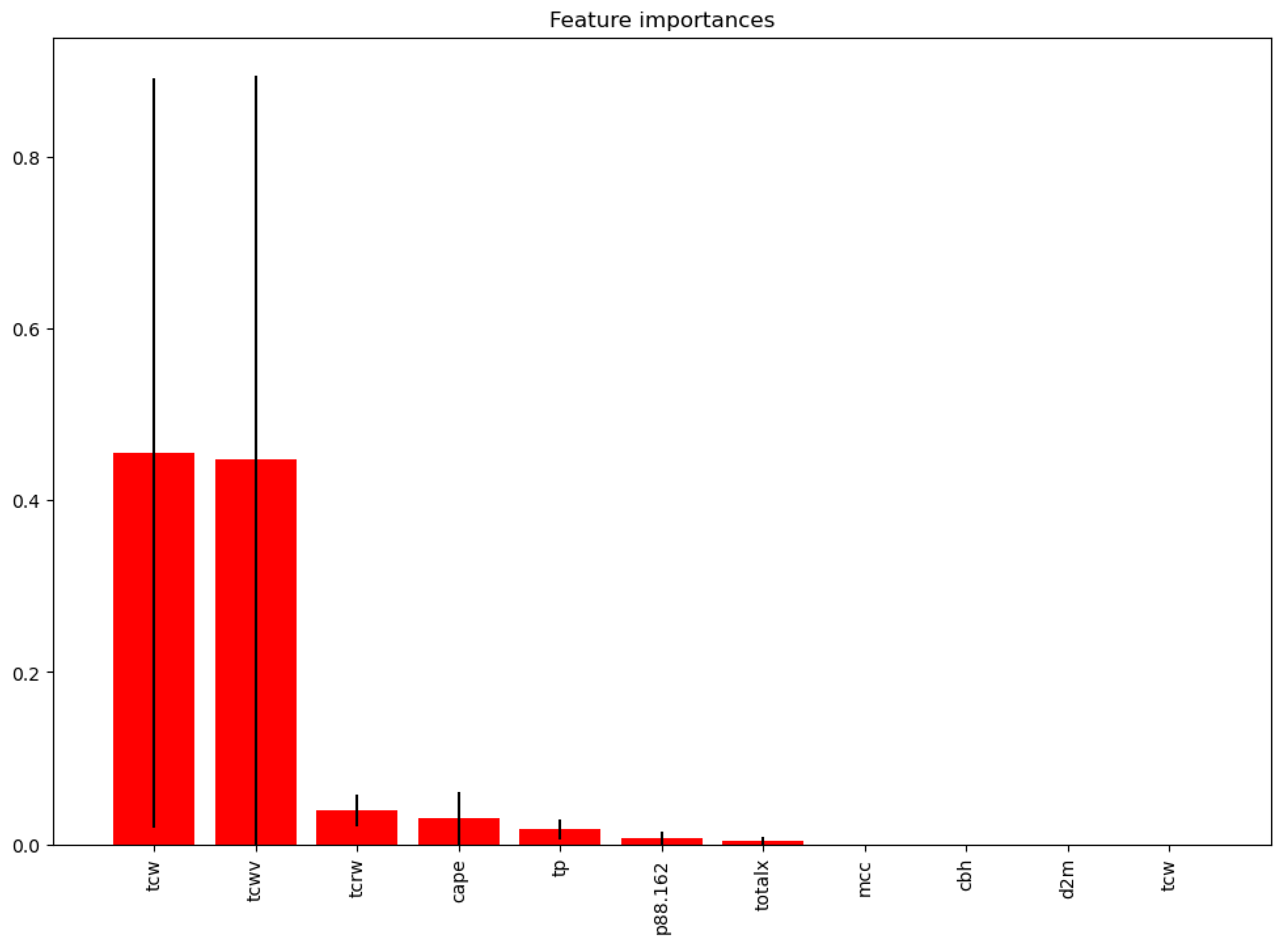
CHAPTER 5
5.1. Recommendations
- Seasonal Planning: utilizes the thunderstorm frequency predictions to optimize planting schedules, especially for crops sensitive to heavy rainfall or strong winds.
- Water Management: Implement improved water management strategies based on predicted thunderstorms patterns, including enhanced drainage systems for period of high thunderstorm activity and water conservation methods for drier period.
- Crop Selection: Consider diversifying crop selection to include varieties more resilient to predicted thunderstorm patterns in the region.
- Risk Mitigation: Develop contingency plan for period of high thunderstorm activity, including measures to protect livestock and secure farm equipment.
- Early Warning Systems: Invest in and implement early warning systems that integrate this thunderstorm prediction model to alert farmers and rural communities about impending severe weather events.
- Infrastructure Development: Prioritize the development of climate resilient agricultural infrastructure, such as improved drainage systems and sheltered storage facilities, in areas prone to frequent thunderstorm.
- Agricultural Insurance: Develop and promote weather-indexed insurance products for farmers, using the thunderstorm prediction model as a basis for risk assessment and policy design.
- Research Funding: Allocate resources for continued research into climate change impacts on local weather patterns and their effects on agriculture in the Wa region.
- Model Refinement: Continue to refine the prediction model by integrating higher resolution data and exploring advanced machine learning techniques such as deep learning or ensemble methods.
- Spatial Analysis: Expand the study to include spatial analysis, mapping thunderstorm frequency and intensity across different parts of the region to identify high-risk areas.
- Climate Change Integration: Investigate the potential impacts of climate change on thunderstorm patterns in the region and integrate these projections into long term prediction model.
- Cross-disciplinary Collaboration: Foster partnership between meteorologist, agronomist, and economist to develop integrated model that link weather predictions directly to agricultural yield forecasts and economic impacts.
- Data Collection Enhancement: Improve the quality and density of weather monitoring stations in the region to provide more accurate and localized data for future model iterations.
- Training Programs: Develop and implement training programs for farmers on interpreting and utilizing thunderstorm predictions in their agricultural decision-making processes.
- Information Dissemination: Establish effective channels for disseminating timely thunderstorm predictions and related agricultural advisories to rural communities, possibly leveraging mobile technologies.
- Adaptive Practices: Promote and teach adaptive agricultural practices that are resilient to variable weather conditions, including soil conservation techniques and crop diversification.
- Methodology Sharing: Share the methodologies and findings of this study to encourage similar research in other regions and other fields of study, facilitating a global understanding of thunderstorm patterns and their agricultural impacts.
- Interdisciplinary Research: Encourage interdisciplinary research projects that combine meteorology, agriculture, economic and social sciences to provide all-inclusive understanding of weather impacts on rural livelihood.
5.2. Conclusion
5.2.1. Key Findings Include:
5.2.2. Contribution of The Research
Acknowledgments
References
- Sharma, A.; Jain, A.; Gupta, P.; Chowdary, V. Machine learning applications for precision agriculture: A comprehensive review. IEEE Access 2020, 9, 4843–4873. [Google Scholar] [CrossRef]
- Anjana, Aishwarya Kedlaya K, Aysha Sana, B Apoorva Bhat, Sharath Kumar, Nagaraj Bhat, An efficient algorithm for predicting crop using historical data and pattern matching technique, Global Transitions Proceedings, Volume 2, Issue 2, 2021. [CrossRef]
- Antwi-Agyei, P.; Fraser, E.D.; Dougill, A.J.; Stringer, L.C.; Simelton, E. Mapping the vulnerability of crop production to drought in Ghana using rainfall, yield, and socioeconomic data. Applied Geography 2012, 32, 324–334. [Google Scholar] [CrossRef]
- Antwi-Agyei, P.; Stringer, L.C.; Dougill, A.J. Livelihood adaptations to climate variability: insights from farming households in Ghana. Regional Environmental Change 2014, 14, 1615–1626. [Google Scholar] [CrossRef]
- Arul, M.; Kareem, A.; Burlando, M.; Solari, G. Machine learning based automated identification of thunderstorms from anemometric records using shapelet transform. Journal of Wind Engineering and Industrial Aerodynamics 2022, 220, 104856. [Google Scholar] [CrossRef]
- Associate For Change (2012). Ghana food security with a focus on upper west region. Mennonite Economic Department Associates.
- Assous, H.F.; AL-Najjar, H.; Al-Rousan, N.; AL-Najjar, D. Developing a Sustainable Machine Learning Model to Predict Crop Yield in the Gulf Countries. Sustainability 2023, 15, 9392. [Google Scholar] [CrossRef]
- Azad MA, K.; Islam AR, M.T.; Rahman, M.S.; Ayen, K. Development of novel hybrid machine learning models for monthly thunderstorm frequency prediction over Bangladesh. Natural Hazards 2021, 108, 1109–1135. [Google Scholar] [CrossRef]
- Bellman, R.E. (1961). Adaptive control processes: a guided tour. Princeton University Press.
- Berry, P.M.; Sterling, M.; Spink, J.H.; Baker, C.J.; Sylvester-Bradley, R.; Mooney, S.J.; Tams, A.R.; Ennos, A.R. Understanding and reducing lodging in cereals. Advances in Agronomy 2004, 84, 217–271. [Google Scholar]
- Buernor, A.B.; Kabiru, M.R.; Chaouni, B.; Akley, E.K.; Raklami, A.; Silatsa, F.B. , … & Jemo, M. (2023). On-farm managed trials and machine learning approaches for understanding variability in soybean yield in Northern Ghana.
- Cao, Q.; Miao, Y.; Feng, G.; Gao, X.; Li, F.; Liu, B. , … & Khosla, R. Coupling machine learning models and crop models to forecast wheat productivity in Kansas. Scientific Reports 2021, 11, 1–13. [Google Scholar] [CrossRef]
- Cedric, L.S.; Adoni WY, H.; Aworka, R.; Zoueu, J.T.; Mutombo, F.K.; Krichen, M.; Kimpolo CL, M. Crops yield prediction based on machine learning models: Case of West African countries. Smart Agricultural Technology 2022, 2, 100049. [Google Scholar] [CrossRef]
- Chandrashekar, G.; Sahin, F. A survey on feature selection methods. Computers & Electrical Engineering 2014, 40, 16–28. [Google Scholar]
- Codjoe, S.N.A.; Owusu, G.; Burkett, V. Perception, experience, and indigenous knowledge of climate change and variability: the case of Accra, a sub-Saharan African city. Regional Environmental Change 2014, 14, 369–383. [Google Scholar] [CrossRef]
- Crane, T.A.; Roncoli, C.; Hoogenboom, G. Adaptation to climate change and climate variability: The importance of understanding agriculture as performance. NJAS-Wageningen Journal of Life Sciences 2011, 57, 179–185. [Google Scholar] [CrossRef]
- Crane, T.A.; Roncoli, C.; Hoogenboom, G. Adaptation to climate change and climate variability: The importance of understanding agriculture as performance. NJAS – Wageningen Journal of Life Sciences 2011, 57, 179–185. [Google Scholar] [CrossRef]
- Di Falco, S.; Veronesi, M. How can African agriculture adapt to climate change? A counterfactual analysis from Ethiopia. Land Economics 2013, 89, 743–766. [Google Scholar] [CrossRef]
- Dormann, C.F.; Elith, J.; Bacher, S.; Buchmann, C.; Carl, G.; Carré; G. , … & Lautenbach, S. Collinearity: a review of methods to deal with it and a simulation study evaluating their performance. Ecography 2013, 36, 27–46. [Google Scholar]
- Doswell III, C.A. (2001). Severe convective storms—An overview. In Severe convective storms (pp. 1-26). American Meteorological Society.
- Emmanuel, K.A. (1994). Atmospheric Convection. Oxford University Press.
- FAO, 2021. The State of Food and Agriculture 2021. Rome, FAO.
- Ghana Statistical Service, 2020. Population and Housing Census: Regional Report – Upper West Region.
- Gijben, M.; Dyson, L.L.; Loots, M.T. A statistical scheme to forecast the daily lightning threat over southern Africa using the Unified Model. Atmospheric Research 2017, 194, 78–88. [Google Scholar] [CrossRef]
- Gijben, M.; Dyson, L.L.; Loots, M.T. A statistical scheme to forecast the daily lightning threat over southern Africa using the Unified Model. Atmospheric Research 2017, 194, 78–88. [Google Scholar] [CrossRef]
- Guyon, I.; Elisseeff, A. An introduction to variable and feature selection. Journal of Machine Learning Research 2003, 3, 1157–1182. [Google Scholar]
- Holle, R.L. , 2008. Annual rates of lightning fatalities by country. 20th International Lightning Detection Conference.
- Howden, S.M.; Soussana, J.F.; Tubiello, F.N.; Chhetri, N.; Dunlop, M.; Meinke, H. Adapting agriculture to climate change. Proceedings of the National Academy of Sciences 2007, 104, 19691–19696. [Google Scholar] [CrossRef]
- Huffman, G.J.; Bolvin, D.T.; Nelkin, E.J.; Wolff, D.B.; Adler, R.F.; Gu, G. , … & Stocker, E.F. The TRMM multisatellite precipitation analysis (TMPA): Quasi-global, multiyear, combined-sensor precipitation estimates at fine scales. Journal of Hydrometeorology 2007, 8, 38–55. [Google Scholar]
- Kamangir, H.; Collins, W.; Tissot, P.; King, S.A. A deep-learning model to predict thunderstorms within 400 km2 South Texas domains. Meteorological Applications 2020, 27, e1905. [Google Scholar] [CrossRef]
- Khaki, S.; Wang, L. Crop yield prediction using deep neural networks. Frontiers in plant science 2019, 10, 621. [Google Scholar] [CrossRef] [PubMed]
- Kotir, J.H. Climate change and variability in Sub-Saharan Africa: a review of current and future trends and impacts on agriculture and food security. Environment, Development and Sustainability 2011, 13, 587–605. [Google Scholar] [CrossRef]
- Lesk, C.; Rowhani, P.; Ramankutty, N. Influence of extreme weather disasters on global crop production. Nature 2016, 529, 84–87. [Google Scholar] [CrossRef]
- Lesk, C.; Rowhani, P.; Ramankutty, N. Influence of extreme weather disasters on global crop production. Nature 2016, 529, 84–87. [Google Scholar] [CrossRef]
- Litta, A.J.; Mohanty, U.C. Simulation of a severe thunderstorm event during the field experiment of STORM programme 2006, using WRF–NMM model. Current Science 2008, 204–215. [Google Scholar]
- Litta, A.J.; Idicula, S.M.; Mohanty, U.C. Artificial neural network model in prediction of meteorological parameters during premonsoon thunderstorms. International Journal of Atmospheric Sciences 2012, 2013. [Google Scholar] [CrossRef]
- Litta, A.J.; Idicula, S.M.; Mohanty, U.C. Artificial neural network model in prediction of meteorological parameters during premonsoon thunderstorms. International Journal of Atmospheric Sciences 2012, 2013. [Google Scholar] [CrossRef]
- Lobell, D.B.; Gourdji, S.M. The influence of climate change on global crop productivity. Plant physiology 2012, 160, 1686–1697. [Google Scholar] [CrossRef]
- Lobell, D.B.; Schlenker, W.; Costa-Roberts, J. Climate trends and global crop production since 1980. Science 2011, 333, 616–620. [Google Scholar] [CrossRef] [PubMed]
- Lontsi Saadio Cedric, Wilfried Yves Hamilton Adoni, Rubby Aworkaa, Jérémie Thouakesseh Zoueuc, Franck Kalala Mutomboa, Moez Krichenf, Charles Lebon Mberi Kimpolo (2022). Crops yield prediction based on machine learning models: Case of West African countries. Elsevier.
- Markowski, P.; Richardson, Y. (2010). Mesoscale meteorology in midlatitudes (Vol. 2). John Wiley & Sons.
- Ministry of food and agriculture (2020). Profile of Upper West Region: Investment Opportunities. https://mofa.gov.gh.
- Ministry of Food and Agriculture, Ghana, 2022. Agriculture in Ghana: Facts and Figures.
- Naab, F.Z.; Abubakari, Z.; Ahmed, A. The role of climate services in agricultural productivity in Ghana: The perspectives of farmers and institutions. Climate Services 2019, 13, 24–32. [Google Scholar] [CrossRef]
- Naveen Kumar Mahanti, Konga Upendar, Subir Kumar Chakraborty (2022). Comparison of artificial neural network and linear regression model for the leaf morphology of fenugreek (Trigonella foenum graecum) grown under different nitrogen fertilizer doses. Elsevier. [CrossRef]
- Nicholson, S.E. The ITCZ and the seasonal cycle over equatorial Africa. Bulletin of the American Meteorological Society 2018, 99, 337–348. [Google Scholar] [CrossRef]
- Nyong, A.; Adesina, F.; Osman Elasha, B. The value of indigenous knowledge in climate change mitigation and adaptation strategies in the African Sahel. Mitigation and Adaptation Strategies for Global Change 2007, 12, 787–797. [Google Scholar] [CrossRef]
- Oikonomidis, A.; Catal, C.; Kassahun, A. Deep learning for crop yield prediction: a systematic literature review. New Zealand Journal of Crop and Horticultural Science 2023, 51, 1–26. [Google Scholar] [CrossRef]
- Owusu, K.; Waylen, P.R. The changing rainy season climatology of mid-Ghana. Theoretical and Applied Climatology 2013, 112, 419–430. [Google Scholar] [CrossRef]
- Paudel, D.; Boogaard, H.; de Wit, A.; Janssen, S.; Osinga, S.; Pylianidis, C.; Athanasiadis, I.N. Machine learning for large-scale crop yield forecasting. Agricultural Systems 2021, 187, 103016. [Google Scholar] [CrossRef]
- Priyatikanto Rhorom, Mayangsari Lidia, Prihandoko Rudi, Admiranto Gunawan 2020 Classification of Continuous Sky Brightness Data Using Random Forest. Advances in Astronomy.
- Ramesh Medar, Vijay S Rajpurohit, Shweta (2019) IEEE 5th international conference for convergence in technology (I2CT), 1-5, 2019.
- Ribeiro, M.T.; Singh, S.; Guestrin, C. (2016). “Why should I trust you?”: Explaining the predictions of any classifier. In Proceedings of the 22nd ACM SIGKDD International Conference on Knowledge Discovery and Data Mining (pp. 1135-1144.
- Rorig, M.L.; McKay, S.J.; Ferguson, S.A.; Werth, P. Model-generated predictions of dry thunderstorm potential. Journal of Applied Meteorology and Climatology 2007, 46, 605–614. [Google Scholar] [CrossRef]
- Rosenzweig, C.; Iglesias, A.; Yang, X.B.; Epstein, P.R.; Chivian, E. Climate change and extreme weather events; implications for food production, plant diseases, and pests. Global Change and Human Health 2001, 2, 90–104. [Google Scholar] [CrossRef]
- Rosenzweig, C.; Iglesias, A.; Yang, X.B.; Epstein, P.R.; Chivian, E. Climate change and extreme weather events; implications for food production, plant diseases, and pests. Global Change and Human Health 2001, 2, 90–104. [Google Scholar] [CrossRef]
- Roudier, P.; Sultan, B.; Quirion, P.; Berg, A. The impact of future climate change on West African crop yields: What does the recent literature say? Global Environmental Change 2011, 21, 1073–1083. [Google Scholar] [CrossRef]
- Saeys, Y.; Inza, I.; Larrañaga, P. A review of feature selection techniques in bioinformatics. Bioinformatics 2007, 23, 2507–2517. [Google Scholar] [CrossRef] [PubMed]
- Shahhosseini, M.; Hu, G.; Archontoulis, S.V. Forecasting corn yield with machine learning ensembles combining crop models and climate data. arXiv, 2020; arXiv:2002.04647. [Google Scholar]
- Shi, W.; Tao, F.; Zhang, Z. A review on statistical models for identifying climate contributions to crop yields. Journal of geographical sciences 2013, 23, 567–576. [Google Scholar] [CrossRef]
- Sivakumar, M.V. Climate extremes and impacts on agriculture. Agroclimatology: Linking Agriculture to Climate 2020, 60, 621–647. [Google Scholar]
- Sorooshian, S.; Hsu, K.L.; Gao, X.; Gupta, H.V.; Imam, B.; Braithwaite, D. Evaluation of PERSIANN system satellite-based estimates of tropical rainfall. Bulletin of the American Meteorological Society 2000, 81, 2035–2046. [Google Scholar] [CrossRef]
- Sylla, M.B.; Nikiema, P.M.; Gibba, P.; Kebe, I.; Klutse, N.A.B. (2016). Climate change over West Africa: Recent trends and future projections. In Adaptation to climate change and variability in rural West Africa (pp. 25-40). Springer, Cham.
- Taylor, C.M.; Birch, C.E.; Parker, D.J.; Dixon, N.; Guichard, F.; Nikulin, G.; Lister, G.M.S. Modeling soil moisture-precipitation feedback in the Sahel: Importance of spatial scale versus convective parameterization. Geophysical Research Letters 2017, 44, 6495–6503. [Google Scholar] [CrossRef]
- Thiaw, W.M.; Gudgel, R.; Jha, B.; Kumar, A.; Murtugudde, R. Seasonal to interannual variability of rainfall over West Africa: A combined GCM and high-resolution satellite study. Journal of Geophysical Research: Atmospheres 2017, 122, 1758–1774. [Google Scholar]
- UNFCCC, Â. (1992). United Nations framework convention on climate change. Oct-2013. [On line]. Available in: http://unfccc. Int/2860. Php. [Access: 01-nov-2014].2.
- Vahid Yousefnia, K.; Bölle, T.; Zöbisch, I.; Gerz, T. A machine-learning approach to thunderstorm forecasting through post-processing of simulation data. Quarterly Journal of the Royal Meteorological Society 2023. [Google Scholar] [CrossRef]
- Veenadhari, S.; Misra, B.; Singh, C.D. (2014, January). Machine learning approach for forecasting crop yield based on climatic parameters. In 2014 International Conference on Computer Communication and Informatics (pp. 1-5). IEEE.
- World Meteorological Organization, 2021. Guidelines on the Definition and Monitoring of Extreme Weather and Climate Events.
- Zhang, X. ; Toudeshki; Ehsani, R.; Li, H.; Zhang, W.; Mac, R. (2022). Yield estimation of citrus fruit using rapid image processing in natural background. Elsevier.
- Yousefnia, K.V.; Bölle, T.; Zöbisch, I.; Gerz, T. A machine-learning approach to thunderstorm forecasting through post-processing of simulation data. arXiv 2023, arXiv:2303.08736. [Google Scholar] [CrossRef]
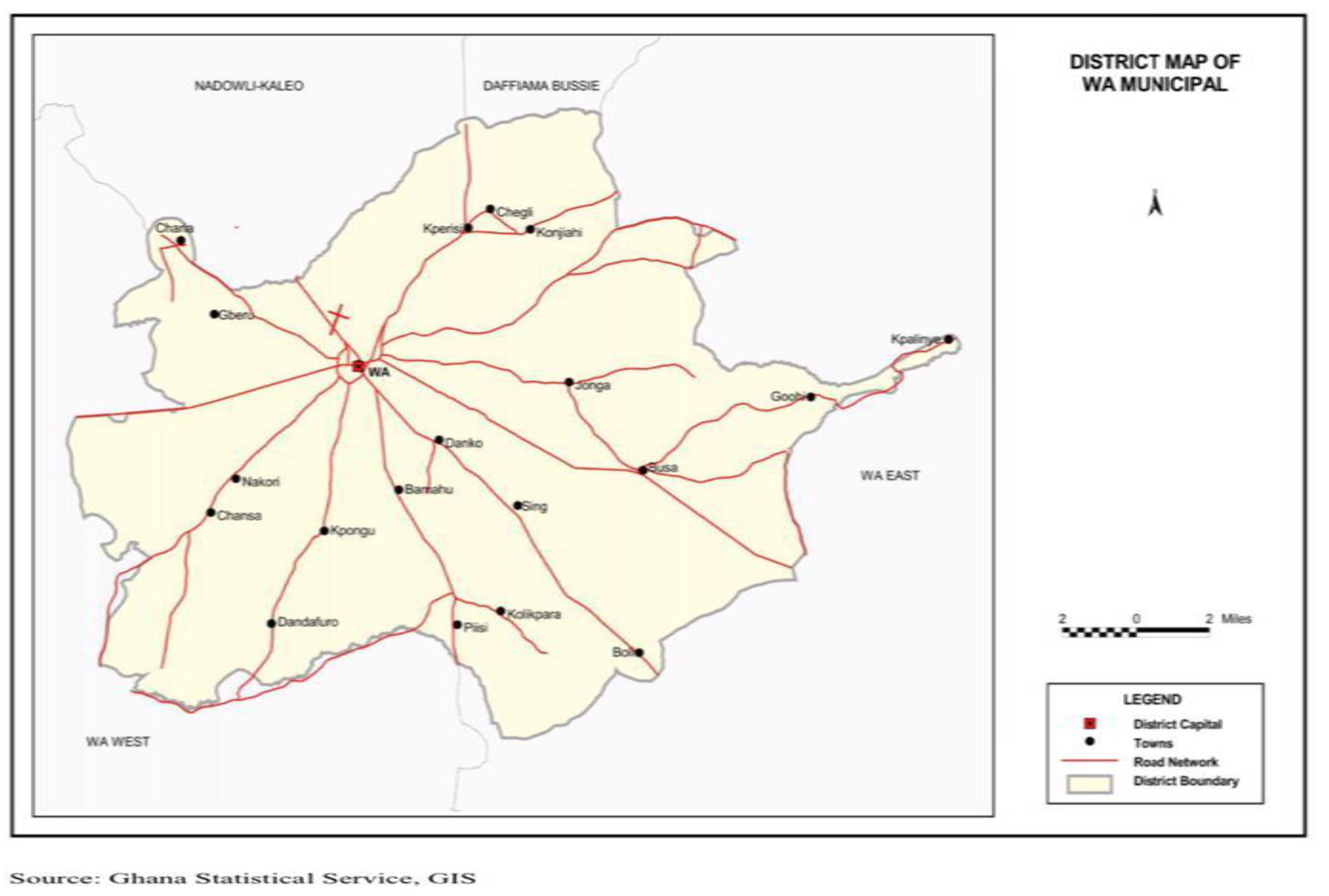
Disclaimer/Publisher’s Note: The statements, opinions and data contained in all publications are solely those of the individual author(s) and contributor(s) and not of MDPI and/or the editor(s). MDPI and/or the editor(s) disclaim responsibility for any injury to people or property resulting from any ideas, methods, instructions or products referred to in the content. |
© 2024 by the authors. Licensee MDPI, Basel, Switzerland. This article is an open access article distributed under the terms and conditions of the Creative Commons Attribution (CC BY) license (http://creativecommons.org/licenses/by/4.0/).





